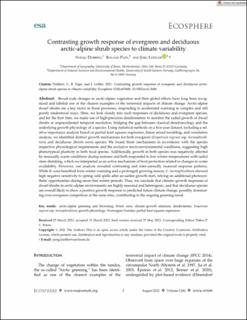| dc.description.abstract | Broad-scale changes in arctic-alpine vegetation and their global effects have long been recognized and labeled one of the clearest examples of the terrestrial impacts of climate change. Arctic-alpine dwarf shrubs are a key factor in those processes, responding to accelerated warming in complex and still poorly understood ways. Here, we look closely into such responses of deciduous and evergreen species, and for the first time, we make use of high-precision dendrometers to monitor the radial growth of dwarf shrubs at unprecedented temporal resolution, bridging the gap between classical dendroecology and the underlying growth physiology of a species. Using statistical methods on a five-year dataset, including a relative importance analysis based on partial least squares regression, linear mixed modeling, and correlation analysis, we identified distinct growth mechanisms for both evergreen (Empetrum nigrum ssp. hermaphroditum) and deciduous (Betula nana) species. We found those mechanisms in accordance with the species respective physiological requirements and the exclusive micro-environmental conditions, suggesting high phenotypical plasticity in both focal species. Additionally, growth in both species was negatively affected by unusually warm conditions during summer and both responded to low winter temperatures with radial stem shrinking, which we interpreted as an active mechanism of frost protection related to changes in water availability. However, our analysis revealed contrasting and inter-annually nuanced response patterns. While B. nana benefited from winter warming and a prolonged growing season, E. hermaphroditum showed high negative sensitivity to spring cold spells after an earlier growth start, relying on additional photosynthetic opportunities during snow-free winter periods. Thus, we conclude that climate–growth responses of dwarf shrubs in arctic-alpine environments are highly seasonal and heterogenic, and that deciduous species are overall likely to show a positive growth response to predicted future climate change, possibly dominating over evergreen competitors at the same sites, contributing to the ongoing greening trend. | en_US |

